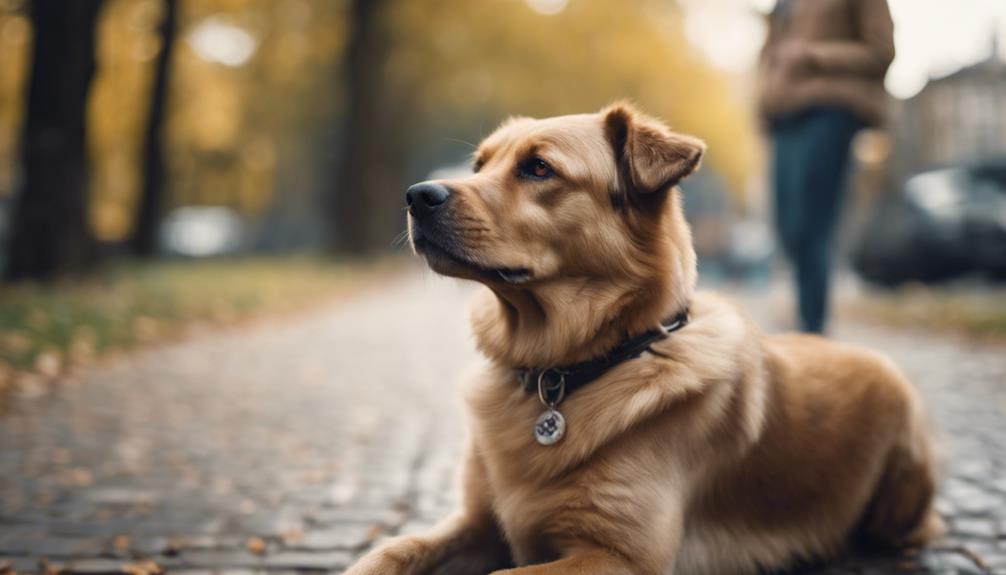The intricate bond between humans and dogs, characterized by unwavering loyalty, is a subject that continues to captivate dog lovers and behavior enthusiasts alike. The depth of this loyalty, rooted in historical, behavioral, and emotional facets, unveils a fascinating narrative of companionship and mutual understanding.
As we unravel the layers of canine loyalty, guided by insights from an experienced trainer and behavior expert, a deeper appreciation for the intricate dynamics at play emerges. What drives dogs to exhibit such steadfast loyalty remains a compelling question, inviting us to explore the profound connections that define our relationships with these remarkable creatures.
Key Takeaways
- Dog loyalty stems from positive experiences, love, and reinforcement.
- Loyalty is nurtured by shared activities, effective communication, and understanding emotions.
- Recognizing loyalty involves observing behaviors like following and positive responses.
- Building trust and a strong bond requires attentive listening and creating a safe environment.
Evolutionary Roots of Dog Loyalty
The Evolutionary Roots of Dog Loyalty
In the historical evolution of the human-canine bond, the loyalty displayed by dogs can be traced back over 23,000 years to a symbiotic relationship that emerged between wild dogs and early humans. This bond was forged as wild dogs found comfort in the companionship and protection offered by humans.
Through this association, dogs evolved into valuable hunting companions, aiding early humans in securing food and providing security. The mutual benefits of this relationship laid the foundation for the deep loyalty that dogs exhibit towards their human counterparts today.
This historical partnership highlights the innate loyalty ingrained in dogs, stemming from their evolutionary history of dependence on and cooperation with humans.
Factors Influencing Canine Loyalty
In exploring the theme of factors influencing canine loyalty, it is essential to understand the pivotal role that integration into an owner's activities and lifestyle plays in fostering a strong bond between dogs and humans. When a dog becomes an integral part of the owner's daily routine, participating in activities, outings, and even relaxation moments, it deepens the connection and sense of belonging for the dog.
Showing respect and kindness towards the dog, understanding its emotions, needs, and wants, and building a strong bond through shared activities and effective communication are also crucial factors. These elements create a foundation for trust, mutual understanding, and a lasting bond that enhances the loyalty dogs exhibit towards their human companions.
Common Misconceptions About Dog Loyalty

Despite prevalent beliefs, misconceptions about dog loyalty often stem from misinterpretations of canine behavior and evolutionary history. One common misconception is the debunked alpha wolf and pack hierarchy concept applied to dogs. Unlike wolves, dogs do not live in packs or adhere to a strict hierarchical structure; instead, they view humans as part of their family group.
Additionally, loyalty in dogs may be perceived differently by humans than by the dogs themselves. Expecting dogs to exhibit loyalty in the same way humans do may not align with their natural behaviors. Understanding these misconceptions is crucial in developing realistic expectations and building a strong bond with our canine companions based on mutual understanding and respect.
Strengthening Dog Loyalty Through Bonding
Enhancing canine loyalty through meaningful interactions and shared experiences is paramount in fostering a strong bond between dogs and their owners. By engaging in activities that resonate with the dog's natural instincts and emotions, owners can deepen their connection with their furry companions. Building trust and understanding through quality time spent together can significantly impact the loyalty a dog shows towards its owner.
| Bonding Activity | Emotional Impact |
|---|---|
| Going on hikes together | Builds trust and excitement |
| Participating in training sessions | Enhances communication and mutual respect |
| Cuddling and playing games | Fosters feelings of love and security |
| Exploring new environments | Stimulates curiosity and strengthens the bond |
| Engaging in interactive feeding routines | Creates a sense of dependency and care |
Behavioral Cues for Understanding Dog Loyalty

Understanding dog loyalty can be facilitated by paying close attention to the behavioral cues exhibited by dogs in response to their owners' actions and interactions. Dogs show loyalty through various behaviors such as following their owners, seeking physical contact, and displaying excitement upon their return. Tail wagging, leaning against their owners, and maintaining eye contact are also common cues indicating loyalty.
Conversely, signs of distress like cowering, avoiding eye contact, or excessive barking could suggest underlying issues affecting the bond. Observing these behavioral cues can provide valuable insights into a dog's feelings and level of attachment, helping owners better understand and nurture the loyalty their canine companions exhibit.
Enhancing and Recognizing Canine Loyalty
Canine loyalty can be strengthened through intentional actions that foster a deep bond between owners and their dogs. To enhance and recognize this loyalty, consider the following:
- Engage in positive reinforcement training to build trust and strengthen the bond.
- Observe and acknowledge signs of loyalty, such as constant companionship and enthusiasm during shared activities.
- Foster loyalty through shared experiences like traveling, exploring new environments, and participating in physical activities together.
Conclusion
In conclusion, the intricate dynamics of canine loyalty stem from a long history of evolution and mutual benefit between humans and dogs. Understanding the factors that influence dog loyalty, dispelling misconceptions, and fostering strong bonds through positive reinforcement and empathetic communication are essential in nurturing and recognizing this enduring bond.
By delving into the behavioral cues of dogs and enhancing the relationship through shared experiences, we can deepen our understanding and appreciation of the unwavering loyalty that dogs exhibit towards their human companions.




